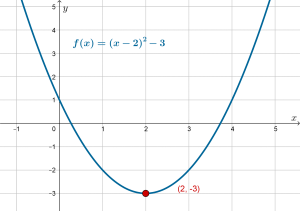Click new a few times to see how the competed square form of the quadratic expression leads us directly to the coordinates of the vertex.
The completed square form is also known as the vertex form.
How it works

To calculate ![]() , the
, the ![]() -coordinate of the vertex, we solve
-coordinate of the vertex, we solve ![]() . This is why:
. This is why:
This parabola has a minimum point. That is, ![]() , or
, or ![]() has a minimum value. The number
has a minimum value. The number ![]() is made up of two parts, we need to find the minimum of each part:
is made up of two parts, we need to find the minimum of each part:
![]()
The first part of ![]() is
is ![]() . What is the minimum value of
. What is the minimum value of ![]() ? This number is a square number. What is the minimum square number? The minimum square number is
? This number is a square number. What is the minimum square number? The minimum square number is ![]() , because
, because ![]() and there are no negative square numbers.
and there are no negative square numbers.
The second part of the number ![]() is the constant
is the constant ![]() . This cannot change.
. This cannot change.
To find the minimum value of both parts of ![]() we need
we need ![]() such that
such that ![]() .
.
Solve
![Rendered by QuickLaTeX.com \begin{align*}(x-2)^2&=0\\[10 pt]x-2&=0\\[10 pt]x&=2\end{align}](https://www.tentotwelvemath.com/wp-content/ql-cache/quicklatex.com-3511d300388747ca191c49133fb60ee0_l3.png)
To calculate ![]() , the
, the ![]() -coordinate of the vertex, we evaluate the function at
-coordinate of the vertex, we evaluate the function at ![]() , which in our case is
, which in our case is ![]() .
.
![Rendered by QuickLaTeX.com \begin{align*}f(x)&=(x-2)^2-3\\[10 pt]f(2)&=(2-2)^2-3\\[10 pt]&=-3\end{align}](https://www.tentotwelvemath.com/wp-content/ql-cache/quicklatex.com-19f68a0ab1210046446d030fbee57e6d_l3.png)
In general, if ![]() , then
, then ![]() and
and ![]() .
.
This is true if the coefficient ![]() is positive or negative.
is positive or negative.
Other ways to find the vertex
Factoring
If the parabola factors, we can easily find the roots. ![]() is half way between the roots, which we can find by
is half way between the roots, which we can find by ![]() . We can then find
. We can then find ![]() by substituting the
by substituting the ![]() value into the equation for
value into the equation for ![]() .
.
Example
![Rendered by QuickLaTeX.com \begin{align*}y&=x^2-2x-8\\[10 pt]\Rightarrow y&=(x-4)(x+2)\\[10 pt]\text{For x-intercepts, }0&=(x-4)(x+2)\\[10 pt]\Rightarrow x&=4 \,\, \text{ or }\,\, x=-2\\[10 pt]\text{For vertex, }x_v&=\dfrac{4+(-2)}{2}=1\\[10 pt]y_v&=(1)^2-2(1)-8=-9\\[10 pt]\text{Vertex is at }&(1,-9)\end{align}](https://www.tentotwelvemath.com/wp-content/ql-cache/quicklatex.com-9714e4e2d3b296333ec9ecd221426616_l3.png)
Formula
We can apply the same process to the roots when they are found using the quadratic formula. The roots are:
![]()
Adding together gives:
![Rendered by QuickLaTeX.com \begin{align*}&\dfrac{-b-\sqrt{b^2-4ac}}{2a} +\dfrac{-b+\sqrt{b^2-4ac}}{2a}\\[10 pt]=&\dfrac{-b-\sqrt{b^2-4ac}+(-b)+\sqrt{b^2-4ac}}{2a}\\[10 pt]=&\dfrac{-2b}{2a}\\[10 pt]=&\dfrac{-b}{a}\end{align}](https://www.tentotwelvemath.com/wp-content/ql-cache/quicklatex.com-63597e30be2c685d40b9dcc5fa739dfa_l3.png)
Dividing by two gives:
![]()
This is a nice, simple formula to use anytime.
Example
![]()
![]()
To calculate the ![]() -coordinate:
-coordinate:
![]()
The coordinates of the vertex are ![]() .
.
Completing the square: Alternative approach
Since we know that if ![]() , then the vertex has coordinates
, then the vertex has coordinates ![]() . Now if we already know the coordinates of the vertex, we can complete the square directly.
. Now if we already know the coordinates of the vertex, we can complete the square directly.
From the calculations in the example above, we see that ![]() has vertex at coordinates
has vertex at coordinates ![]() . That is,
. That is, ![]() and
and ![]() . Also, the leading coefficient
. Also, the leading coefficient ![]() . Therefore
. Therefore
![]()
